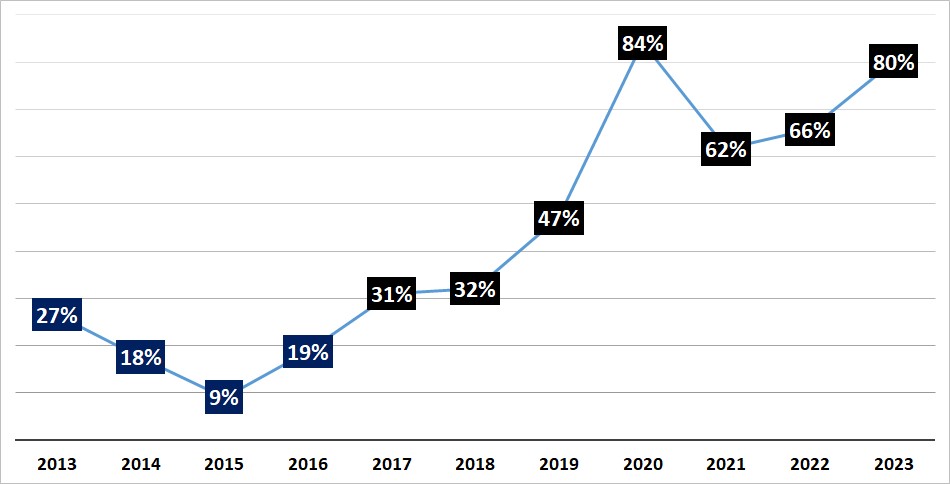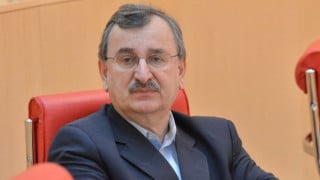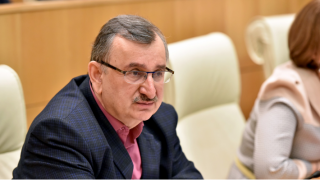Roman Gotsiridze: “Reinvestment constituted 90% of the total investment in 2023.”
Verdict: FactCheck concludes that Roman Gotsiridze’s statement is MOSTLY TRUE.
Foreign direct investment in Georgia experienced a 24% reduction, decreasing from USD 2.1 billion to USD 1.6 billion in 2023 as compared to 2022. Notably, the reinvestment rate reached its highest mark since GeoStat began recording investment component data, excluding 2020.
Total investment has substantially declined with regard to the GDP in addition to its monetary value. Furthermore, this downward trend persisted in the first quarter of 2024.
Whilst the MP’s statement regarding the 24% reduction in total investment, amounting to a decline of USD 500 million in monetary terms, is accurate, the reinvestment rate is 80% rather than 90%. Thus, considering all of the above, FactCheck concludes that Roman Gotsiridze’s statement is MOSTLY TRUE.
Analysis
Roman Gotsiridze, a member of the Eurooptimists parliamentary group, during his appearance on TV24, commented on investment, stating (from 5:50): “Total investment witnessed a decline of 24% in 2023 as compared to 2022, amounting to approximately USD 500 million less. However, do you wonder what aspect is the most astounding? A total of 90% of foreign direct investment comprised reinvestment.”
Georgia witnessed the highest monetary value of foreign direct investment in 2022, namely USD 2.1 billion. However, the initial three quarters of the following year were characterised by a downward trend, leading to a substantial USD 500 million decline to USD 1.6 billion. Nearly USD 1.3 billion of the aforementioned USD 1.6 billion was reinvestment, reaching an 80% share.
Three main channels of foreign direct investment (FDI) are: equity capital, reinvestment and debt liabilities. GeoStat began storing each component separately in 2013. The lowest reinvestment figure of 9% was recorded in 2015 whereas the highest value of 84% was observed in 2020.
The so-called Estonian Model was adopted in 2017 under which a company is exempt from profit tax if it reinvests its profit. Notably, whilst profit taxes contributed over GEL 1 billion to the state budget in 2016, this figure experienced a GEL 300 million decline, constituting GEL 757 million in 2017. However, the reduction was compensated by increasing the excise tax on tobacco products and petrol.
The aforementioned reform also had an evident impact on investment. The reinvestment rate reached 31% in 2017, followed by an increase to 47% in 2019. Whilst the average reinvestment rate amounted to 18% from 2013 to 2016, the figure tripled to 57% in 2017-2023. The average reinvestment rate still amounts to 51% even excluding the pandemic years of 2020 and 2021 following the alterations in the Tax Code of Georgia.
Graph 1: Reinvestment Rate in Foreign Direct Investment

Source: National Statistics Office of Georgia
The lowest value of the reinvestment rate at 31% observed in 2017, hence following the tax reform, is larger than its highest mark (27% in 2013) prior to the change.
Although both stock capital and reinvestment, with investors reinserting the profits back into the market, are beneficial from an economic standpoint, a lack of new investment point toward certain underlying issues.
Another measure of investment is its relative value to the GDP. It is worth mentioning that the investment-to-GDP ratio decreased to 5.3% in 2023, marking its lowest level in the past 20 years, excluding the pandemic period.
As of June, only the data from the first quarter of 2024 has been made available thus far, indicating an additional 64% decrease in investment to USD 201 million.
Overall, the MP’s claims regarding the reduction in investment, as well as the substantial share of reinvestment in total investment are accurate. However, the reinvestment rate is 80% rather than 90%. Thus, considering all of the above, FactCheck concludes that Roman Gotsiridze’s statement is MOSTLY TRUE.








